Travel Guide Kuala Lumpur: 3-Day Itinerary
Travel Guide
Kuala Lumpur
Kuala Lumpur, also known as the “Heart of Malaysia,” is a fascinating city located in the heart of Southeast Asia. This vibrant and energetic city harmoniously blends rich tradition with effervescent modernity, offering a captivating experience for travelers. Celebrated for its spectacular urban landscape, diverse mix of cultures, and exotic culinary delights, Kuala Lumpur is an unforgettable destination for explorers and adventurers from around the world.
Kuala Lumpur Itinerary
This comprehensive guide will take you on an unforgettable adventure through Kuala Lumpur, the vibrant capital of Malaysia. Get ready to explore a fascinating blend of cultures, stunning architecture, and a delicious culinary scene.
3 days in Kuala Lumpur
Day 1: Petronas Twin Towers and Surroundings
Petronas Towers and Ramlee Suria Mall: We started the day by visiting the iconic twin towers and the adjacent shopping center. The Petronas Twin Towers, inaugurated in 1999, were the tallest buildings in the world until 2004 and remain an iconic symbol of Malaysia. The twin towers stand at a height of 452 meters and are connected by a suspended bridge (Skybridge) at levels 41 and 42. The design of the towers reflects Islamic motifs, in accordance with the country’s predominant religion. Visitors have the option to ascend to the bridge between the Petronas Towers; tickets can be purchased online or directly there. Visitors can also go up to level 86, where the observation deck offers impressive panoramic views of the city of Kuala Lumpur.
Jalan Pinang: A stroll along this street gave us a glimpse of the city’s modern architecture. Jalan Pinang is a major artery in Kuala Lumpur, providing access to some of the city’s most famous attractions and facilities. Whether you’re interested in shopping, business, luxury accommodation, or simply want to explore the vibrant heart of Kuala Lumpur, Jalan Pinang is a key location not to be missed.
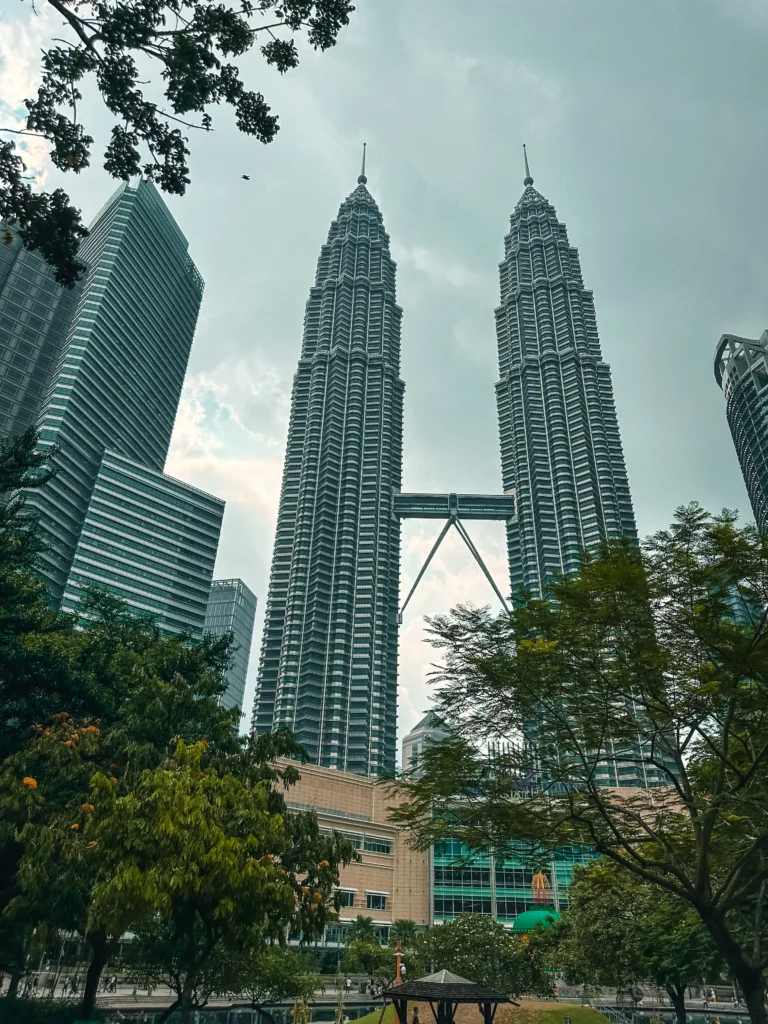
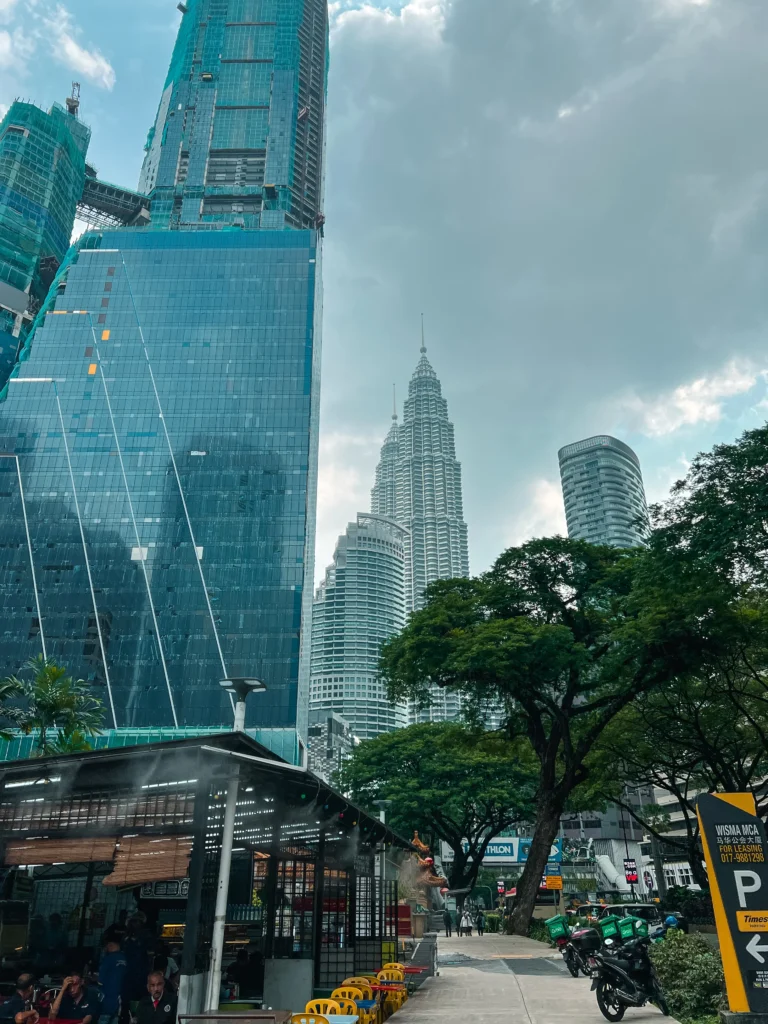
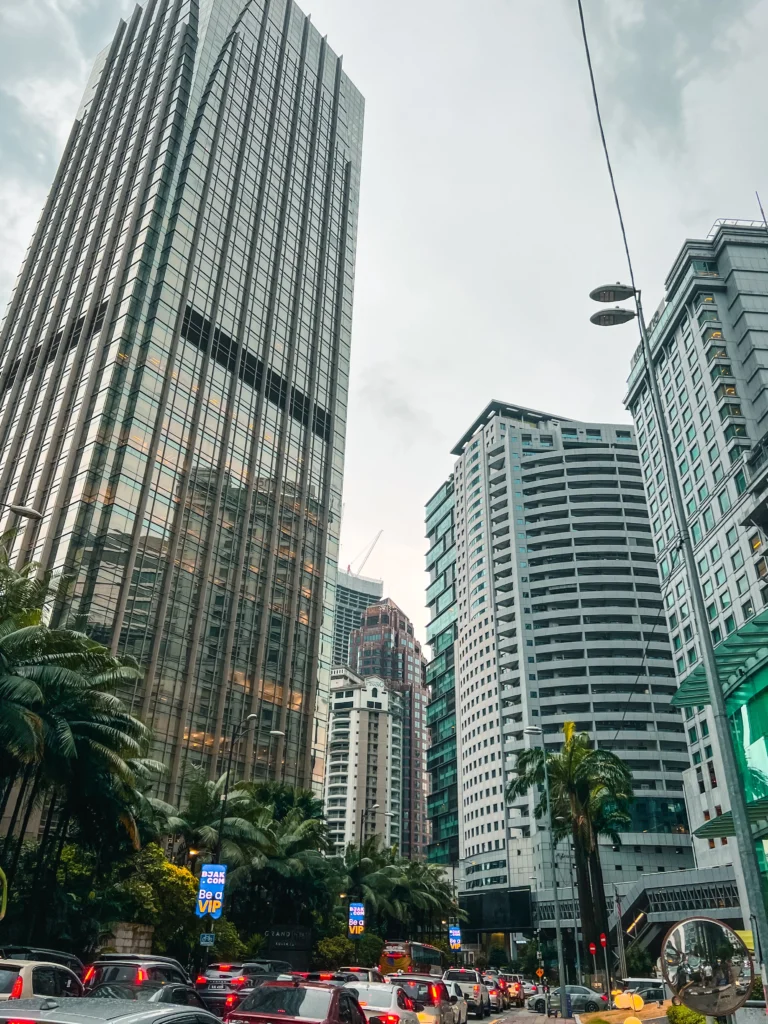
- Bukit Bintang: is considered the heart of entertainment and commerce in Kuala Lumpur. It’s a popular destination for both locals and tourists due to its numerous shopping centers, restaurants, bars, and nightclubs.
- Bukit Bintang Intersection: This bustling intersection is one of Kuala Lumpur’s most recognizable landmarks. It’s located where Jalan Bukit Bintang meets Jalan Sultan Ismail. The intersection is known for its multiple pedestrian crossings and vibrant atmosphere, with giant LED screens and bright advertisements reminiscent of New York’s Times Square.
- Multiple Pedestrian Crossings: The intersection is equipped with pedestrian crossings allowing crossing in all directions, including diagonally, providing a unique and safe pedestrian experience. It’s a highly photogenic area and a perfect spot to capture urban bustle.
- Jalan Alor Food Street: Here, I enjoyed delicious mango sticky rice and the controversial durian fruit. Durian is famous (or infamous) for its strong and pungent odor, often compared to rotting onions, dirty socks, turpentine, and other unpleasant scents. The smell is so intense that many hotels and public transportation systems in Southeast Asia ban durian consumption indoors. The taste of durian is complex and sweet, with notes of almonds, cream, and sometimes onions. Its texture is creamy, similar to ripe avocado. Durian is rich in calories, vitamins, and minerals, serving as a good source of carbohydrates, fiber, vitamin C, potassium, and other essential nutrients. In many Southeast Asian cultures, consuming durian is a tradition and cultural symbol, often enjoyed on special occasions as a delicacy.
I walked from the accommodation to visit these tourist attractions.
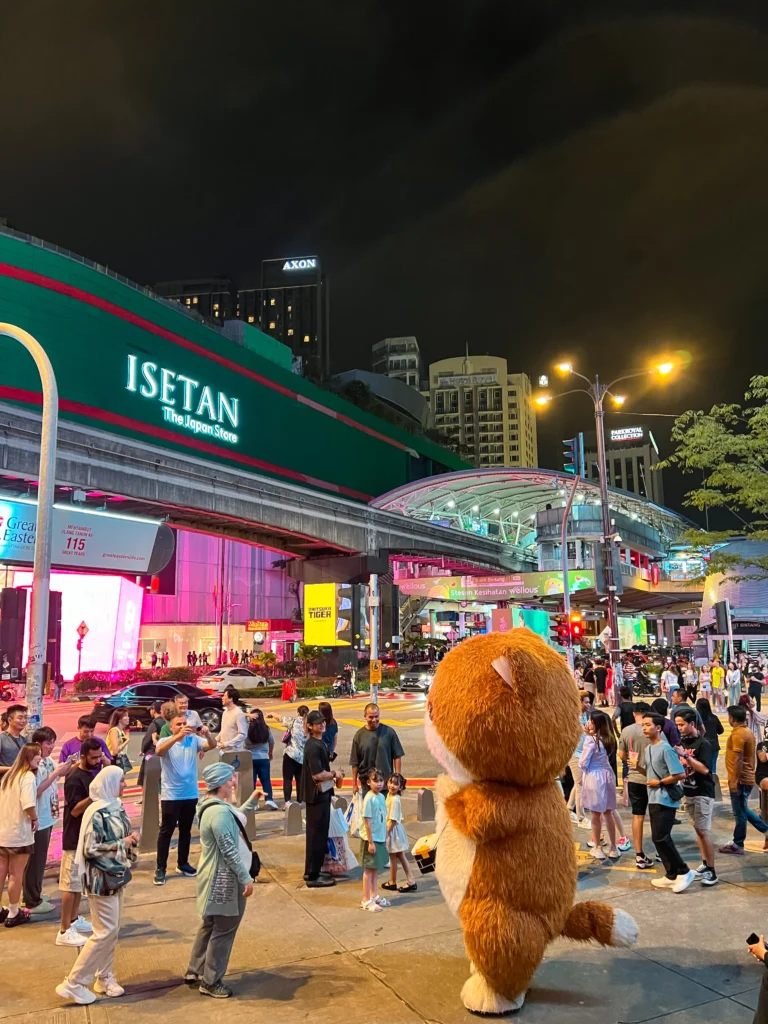

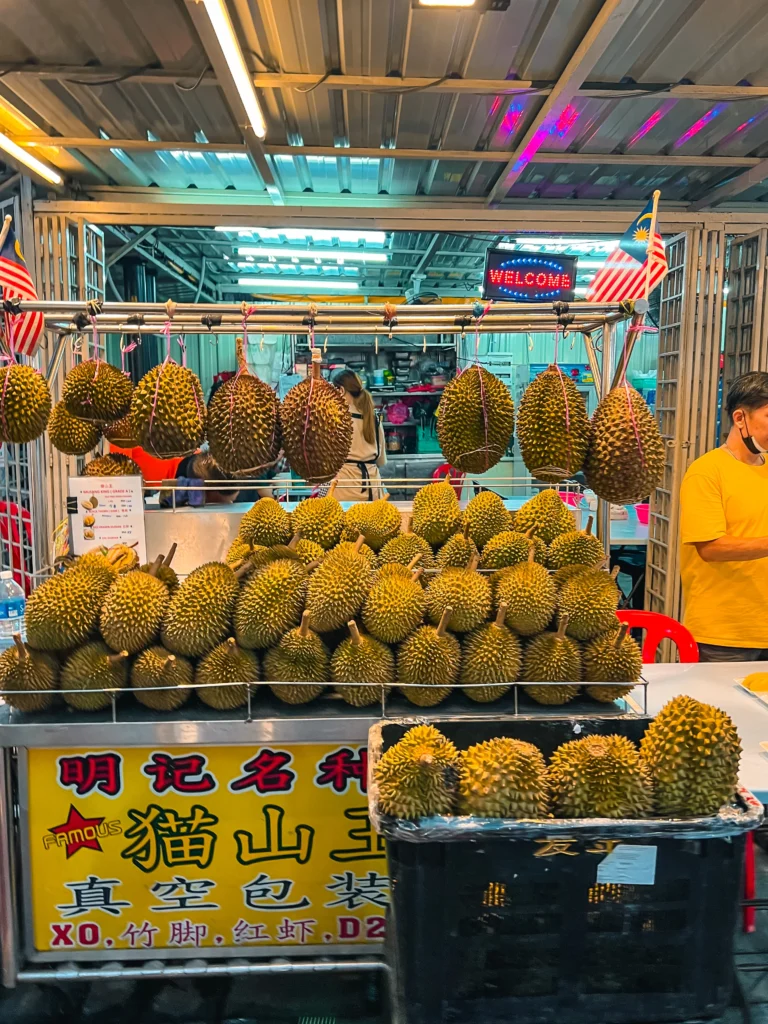
Day 2: Batu Caves and Shopping
Batu Caves:
Batu Caves were formed approximately 400 million years ago. The caves were discovered by local explorers in the 19th century and quickly became an important site for the Hindu community. These limestone caves are a significant pilgrimage site for Hindus in Malaysia. The main entrance is dominated by an impressive gilded statue of Lord Murugan, standing 42.7 meters tall. The main cave, also known as the Temple Cave, is accessible by climbing 272 colorful steps. Entrance is free, but some inner caves require a fee.
At Batu Caves, you need to be cautious with your personal belongings due to the monkeys, which can be very curious.
We chose to go to Batu Caves by Grab, as it was quite hot even early in the morning. The ride from the hotel to Batu Caves cost 38.5 MYR (approx. 8 USD).
Batu Caves represents a fascinating combination of nature and spirituality, offering an unforgettable cultural and visual experience. Whether you are interested in history, religion, or simply impressive landscapes, this place is a must-see attraction in Kuala Lumpur.
How to Get to Batu Caves
Train
- Route: Take the KTM Komuter train from KL Sentral station to Batu Caves.
- Duration: Approximately 30 minutes.
- Cost: The ticket is cheap, around 2-3 MYR (less than 1 USD).
- Frequency: Trains run frequently, at intervals of about 30 minutes.
Taxi/Grab
- This is the option we chose
- Duration: Approximately 20-30 minutes, depending on traffic.
- Cost: Around 20-30 MYR (approximately 5-8 USD) for a ride from Kuala Lumpur city center to Batu Caves.
- Advantages: It is convenient and quick, especially if traveling with luggage or in a group. Grab is very popular in Malaysia and often cheaper than traditional taxis.
Bus – Local Buses
- Route: Take the U6 bus from Pudu Sentral Terminal or other buses that have a route to Batu Caves.
- Duration: Approximately 45-60 minutes, depending on traffic.
- Cost: Around 3-5 MYR (less than 2 USD).
- Advantages: It is an economical option but can be less comfortable and slower than the train or taxi.
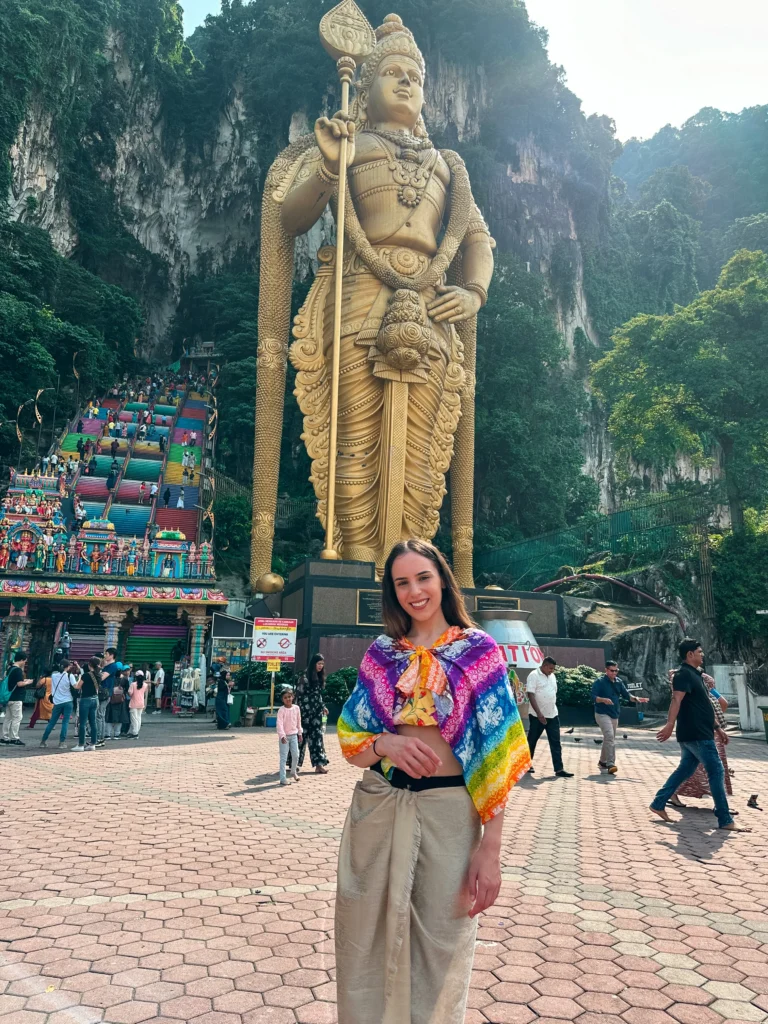
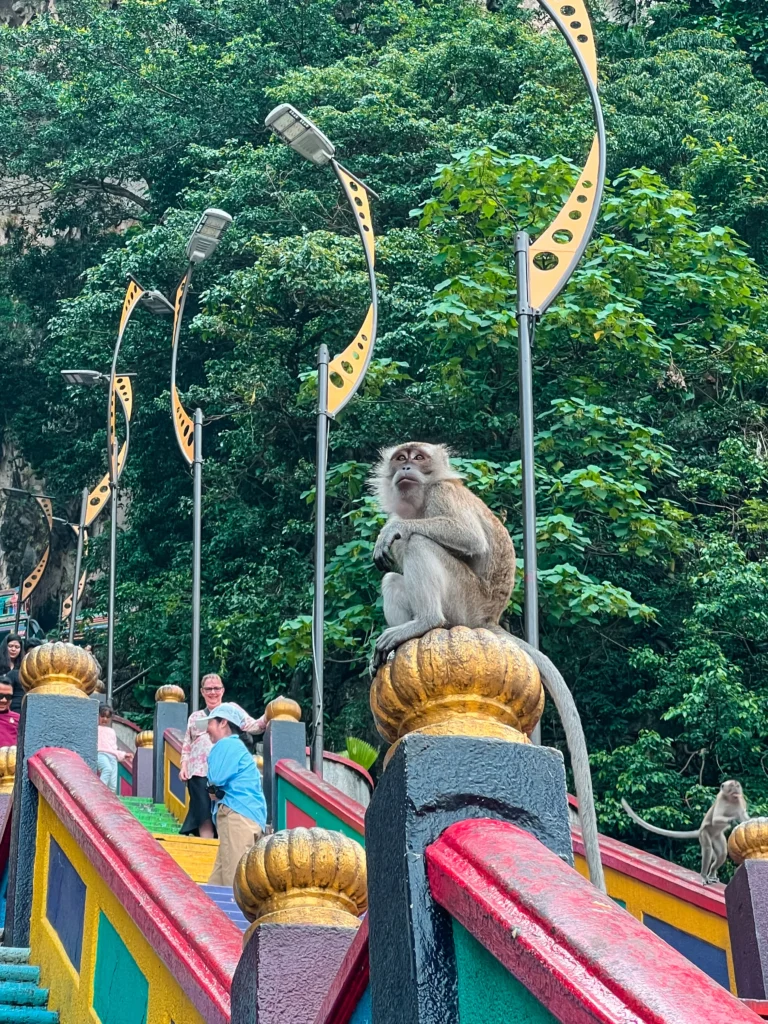
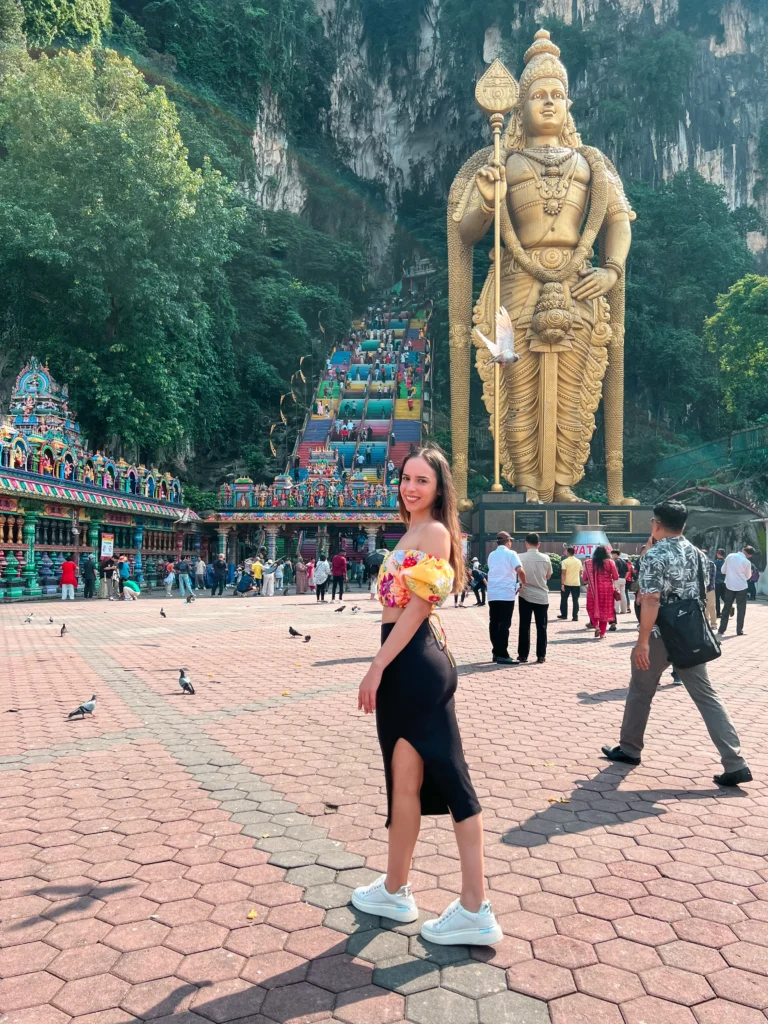
Jalan Petaling Street
This is the main street in Chinatown, famous for its souvenir stalls and cheap shopping. All prices here are negotiable. We negotiated a Dior backpack down from 300 MYR to 120 MYR. The products are of good quality, but negotiating requires patience. Tips: If you go in the morning and are among the first customers, the sellers will give bigger discounts, saying that the first customer will bring them good luck for the whole day.
Dataran Merdeka
Independence Square is a historic site where Malaysia declared its independence from Britain in 1957. The square is surrounded by impressive colonial buildings and hosts events and parades.
Machines Store in Pavilion Mall
If you are passionate about Apple products, visit the Machines store for lower prices on Apple products. We found this store in Pavilion Mall, which was close to our hotel.
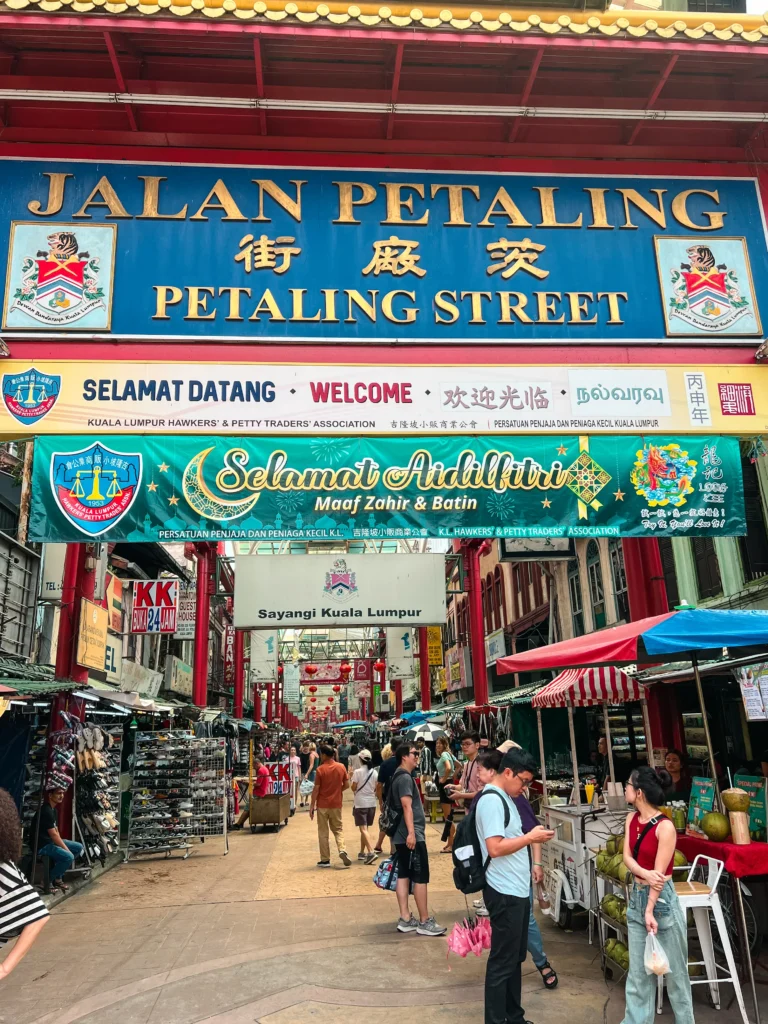
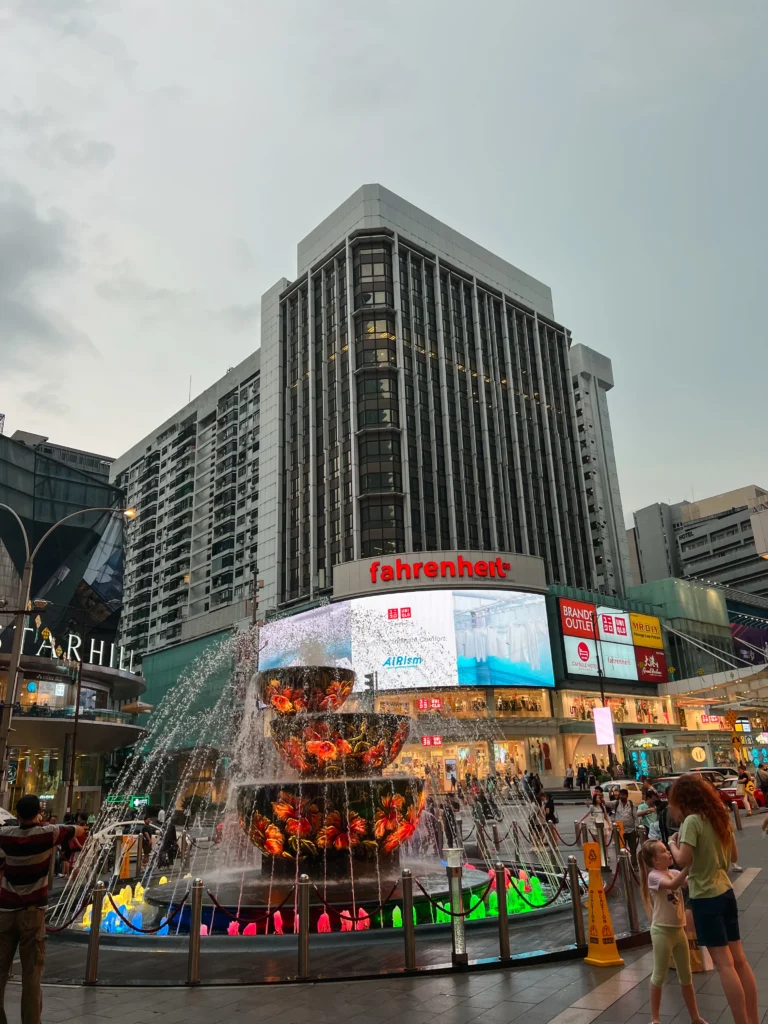
Day 3: Discovering Modernity and Nature in Kuala Lumpur
Central Market
An ideal place to discover local art and culture, Central Market offers a variety of handcrafted products, souvenirs, and artworks. It is a perfect destination to gain a better understanding of local traditions and customs.
KL Tower (Menara Kuala Lumpur)
Another iconic structure in Kuala Lumpur, KL Tower offers stunning views of the city. You can go up to the observation deck or dine at the revolving restaurant Atmosphere 360 for an unforgettable experience.
KL Forest Eco Park
One of the few tropical forests located in the heart of a city, KL Forest Eco Park offers canopy walks and a green oasis amidst the urban hustle and bustle.
Petronas Twin Towers
The Petronas Twin Towers look impressive at night. The buildings are splendidly illuminated, with a light show that highlights their distinctive architectural beauty. The light reflecting off their tall windows creates an elegant and modern atmosphere throughout the city’s financial district.
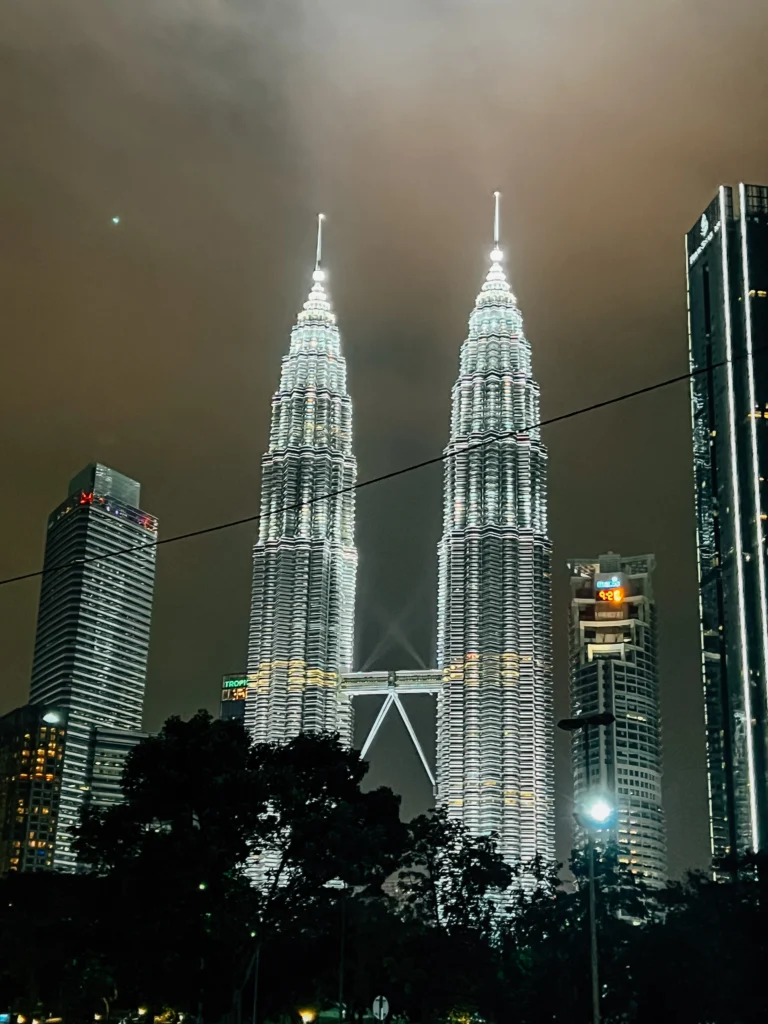
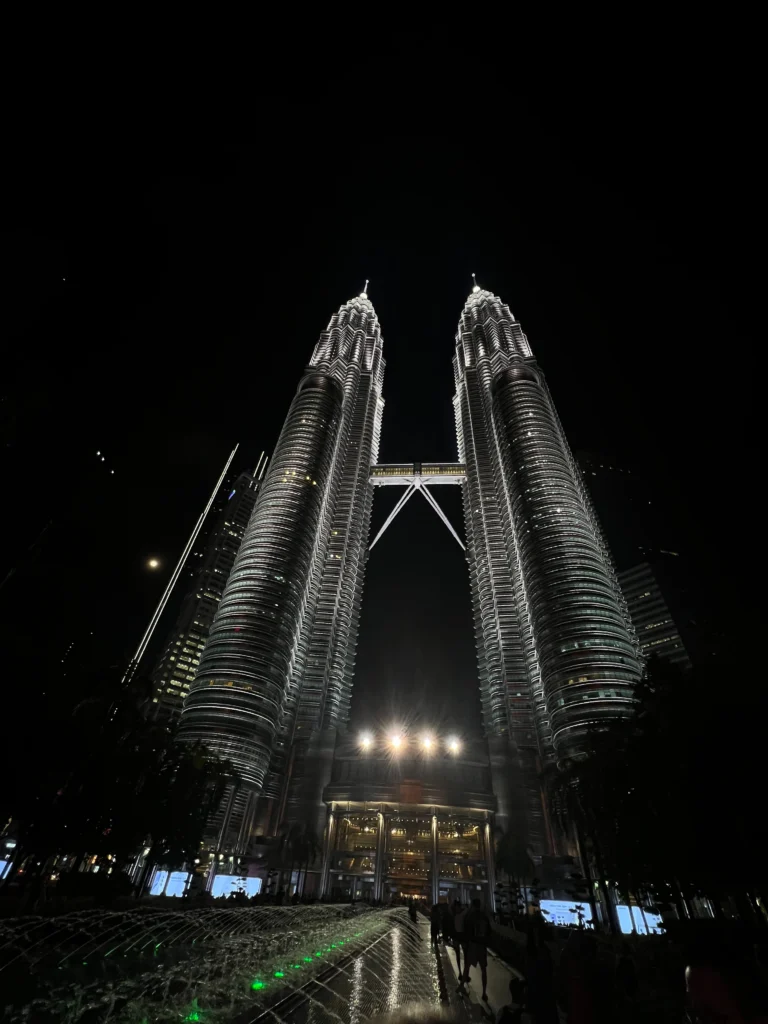
Recommended Restaurants in Kuala Lumpur
McDonald’s and KFC
Curious about the taste of local fast-food offerings, we tried the classic Big Mac and Chicken McNuggets at McDonald’s, which tasted similar to the usual ones. At KFC, we sampled Nasi Lemak, a traditional Malaysian dish consisting of rice cooked in coconut milk, served with fried chicken, boiled egg, anchovies, and peanuts.
Restaurant Damascut Kuala Lumpur
The food was extremely good and offered an unforgettable culinary experience.
Jalan Alor Food Street
On Jalan Alor Food Street in Kuala Lumpur, you can find a wide variety of delicious dishes and snacks, each reflecting the diversity of Malaysian and Asian cuisine. Popular dishes you can enjoy include:
Satay: Skewers of marinated meat (usually chicken or beef) grilled over charcoal and served with a peanut sauce.
Nasi Goreng: A traditional dish of fried rice with vegetables, egg, and sometimes meat or seafood.
Bak Kut Teh: A Chinese soup made with pork, flavored with herbs and spices.
Ikan Bakar: Grilled fish marinated in spices and sauces, served with rice and vegetables.
Mango Sticky Rice: A sweet delicacy from Thailand, consisting of sticky rice topped with fresh mango slices and drizzled with coconut milk.
Durian: The controversial fruit, known for its strong odor but appreciated for its sweet and creamy taste.
Dim Sum: Chinese appetizers, such as dumplings and steamed buns filled with various ingredients.
Seafood: Fresh seafood prepared in various ways, including crab, calamari, or shrimp.

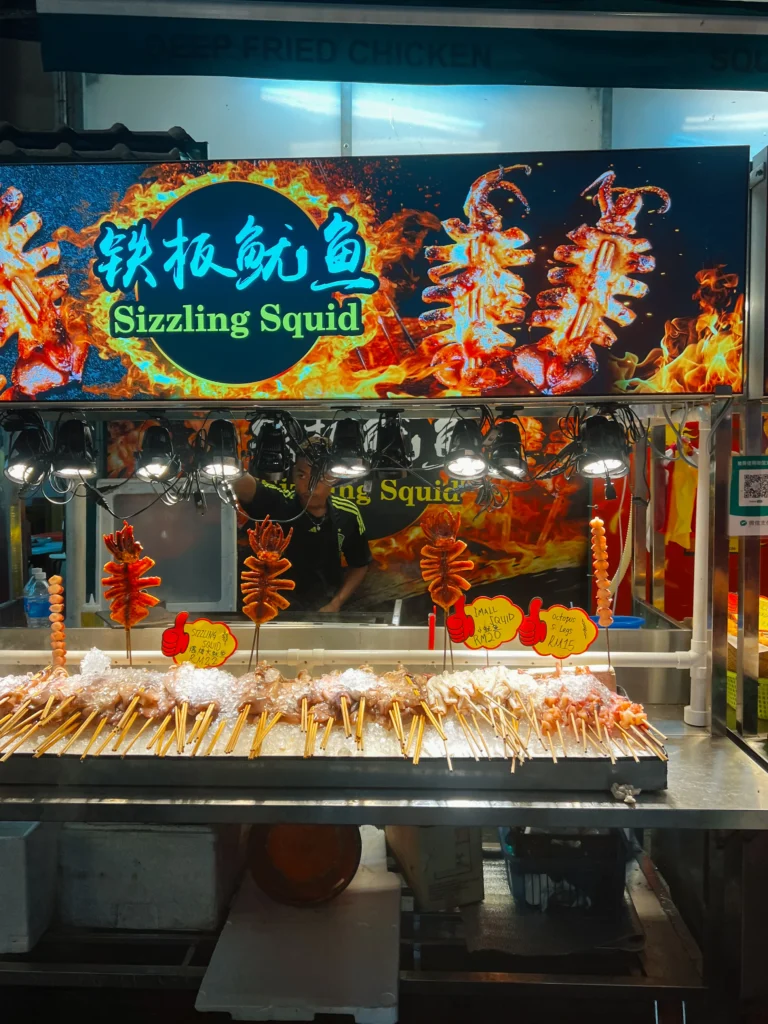
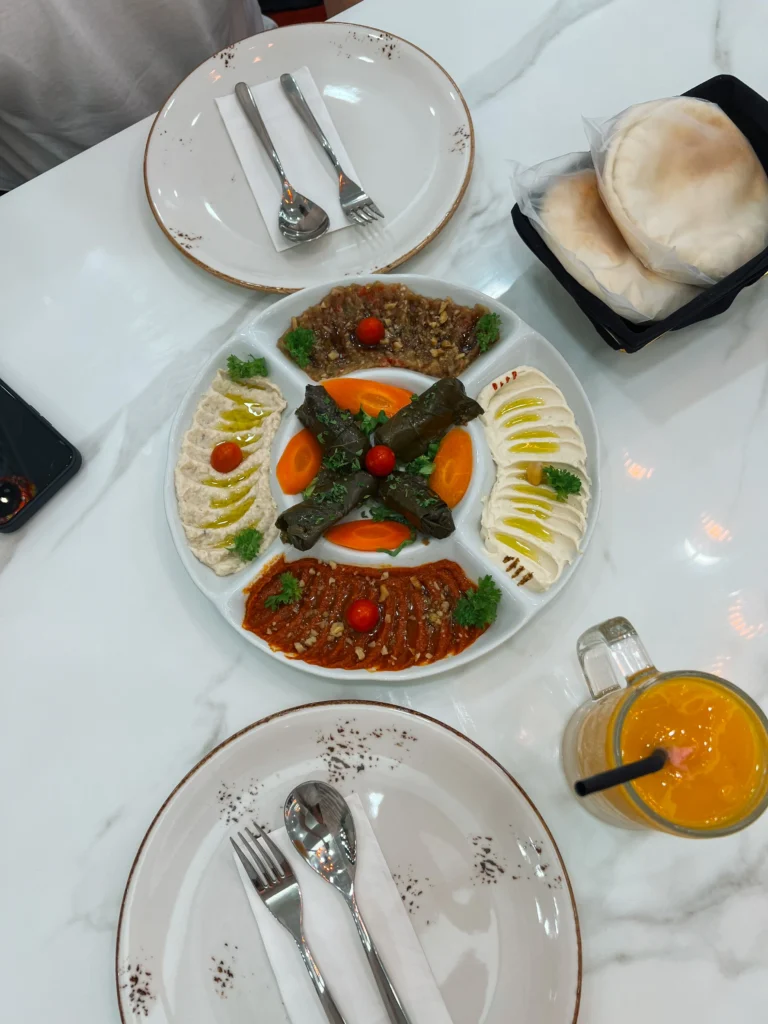
Best time to visit Kuala Lumpur
Kuala Lumpur is a great destination year-round, but the best time to visit depends on what you prioritize:
Pleasant weather with less rain:
- July and August: These are generally the driest months in Kuala Lumpur, with sunshine and hot temperatures (around 32°C or 90°F). Perfect weather for exploring the city and outdoor activities, but expect higher crowds and hotel prices.
Shoulder seasons with a good balance:
- January and February: These months offer warm weather (around 28°C or 82°F) with less rain compared to the rest of the year. Crowds are also smaller, and you might find better deals on flights and accommodation.
- May and June: Another shoulder season with slightly more rain than January and February, but still generally pleasant weather. You might encounter some occasional showers, but these typically don’t last long.
Lower crowds and potential savings:
- March and April: These months see the most rain in Kuala Lumpur, but it’s usually short bursts rather than continuous downpours. You’ll find the lowest crowds and potentially the best deals on travel costs, but be prepared for some rain showers.
- September to November: Similar to March and April with higher chances of rain, but also lower tourist numbers and potentially cheaper travel options.
Festivals and events:
- Chinese New Year (January or February): A vibrant celebration with parades, lion dances, and delicious food. Be prepared for larger crowds and higher prices.
- Ramadan (varies depending on the lunar calendar): During this holy month for Muslims, many restaurants close during the day, but there are still plenty of options for non-Muslims.
- Malaysia Day (September 16th): A national holiday with parades and cultural events.
Here’s a quick summary:
- Best weather: July and August (hot, sunny, less rain)
- Good balance: January, February, May, June (warm, less rain)
- Lower crowds: March, April, September to November (more rain)
- Festivals: Chinese New Year (January/February), Malaysia Day (September 16th)
Ultimately, the best time to visit Kuala Lumpur depends on what you’re looking for in your trip. Consider your priorities for weather, crowds, and budget to make the perfect choice!
Flights:
We chose to fly with Qatar Airways on the route Bucharest – Doha – Singapore, with a 4-hour layover in Doha, and on the return Bali (Denpasar) – Doha – Bucharest.
From Singapore, we flew to Kuala Lumpur, and from Kuala Lumpur to Bali with the low-cost airline AirAsia. Tickets for these 2 routes were purchased one and a half months before departure, which is the perfect time to find cheap plane tickets.
On the return journey, we had a 12-hour and 30-minute layover in Doha, and luckily, we found out that Hamad International Airport in Doha offers several-hour tours to visit the city of Doha or other activities around the city, which you can find on their website. We opted for a Doha city tour with a guide, which made the layover time pass much faster, and they guide you throughout for getting out and returning to the airport. I should mention that you need a minimum 8-hour layover to opt for these tours.
Tickets on Qatar Airways were purchased 7 months before departure.
Accommodation:
We chose accommodation as close as possible to the Petronas Twin Towers so that we could walk there. Our accommodation for 3 nights was at Perdana Kuala Lumpur City Centre. The hotel is nice, the rooms are spacious, the breakfast is extremely varied, and the pool on the 9th floor offers a spectacular view of the skyscrapers in the area.
Additional Information:
-
Location: The hotel is located approximately 1 km from the Petronas Twin Towers, a distance that is easily walkable.
-
Amenities: In addition to the rooftop pool, the hotel offers a variety of amenities to enhance your stay, including:
-
Fitness Center: Stay active and maintain your workout routine even while on vacation with the hotel’s well-equipped fitness center.
-
Spa: Indulge in some pampering and relaxation at the hotel’s spa, where you can choose from a range of treatments to rejuvenate your body and mind.
-
Restaurant: Enjoy delicious meals without having to leave the hotel. The on-site restaurant offers a variety of cuisines to satisfy your taste buds.
-
Bar: Unwind and socialize with a refreshing drink at the hotel’s bar, where you can mingle with other guests or simply enjoy a quiet moment.
Connectivity:
Staying connected is easy at Perdana Kuala Lumpur City Centre, thanks to the complimentary Wi-Fi available throughout the hotel. Whether you’re checking emails, browsing the internet, or staying in touch with loved ones, you’ll have seamless access to the online world.
Recommendations:
To make the most of your stay at Perdana Kuala Lumpur City Centre, consider these recommendations:
-
Book Early: Especially if you’re traveling during peak season or during special events, it’s advisable to secure your accommodation well in advance to ensure availability and potentially get better rates.
-
Request a City View Room: If you want to experience the breathtaking panoramic views of Kuala Lumpur’s skyline, consider requesting a city view room. The hotel’s staff will do their best to accommodate your preference.
-
Relax by the Rooftop Pool: After a day of exploring the city and its attractions, take some time to unwind and enjoy the refreshing waters of the rooftop pool. The pool offers a tranquil escape amidst the city’s vibrant atmosphere.
Alternative Accommodation Options near Petronas Twin Towers:
If you’re looking for other accommodation options near the iconic Petronas Twin Towers, here are some highly-rated choices:
-
Mandarin Oriental Kuala Lumpur: This luxurious hotel is located right next to the Petronas Twin Towers, offering unparalleled convenience and access to the city’s most famous landmark.
- The Ritz-Carlton Kuala Lumpur: Another luxury hotel located in the heart of Kuala Lumpur.
- Traders Hotel Kuala Lumpur: A modern hotel located in Kuala Lumpur’s Chinatown.
-
Entry Conditions for Kuala Lumpur, Malaysia
Romanian citizens do not need a visa to enter Malaysia. You can stay in the country for up to 90 days for tourism, business, or visiting friends or family. Entry Conditions:- A passport valid for at least 6 months from the date of arrival in Malaysia (including for airport transit) with at least one blank page for the entry stamp.
- A return flight ticket or a flight ticket to another destination.
- Proof of accommodation (hotel reservations, Airbnb, etc.) or an invitation from a person residing in Malaysia.
- Sufficient funds to cover expenses during the stay (a minimum of 50 USD per day is recommended).
- Travel medical insurance covering hospitalization and repatriation costs.
- It is recommended to complete the electronic arrival form at least 24 hours before your flight.
- Ensure you have copies of the necessary documents (passport, flight ticket, accommodation, etc.).”
How to Get from Kuala Lumpur International Airport (KLIA) to the City Center
Transportation Options
1. KLIA Ekspres / KLIA Transit
- Duration: Approximately 28 minutes (KLIA Ekspres) / 35-40 minutes (KLIA Transit)
- Cost: 55 MYR (approximately 12 USD) for a one-way ticket
- Frequency: Every 15 minutes (peak hours) and 20 minutes (off-peak hours)
- Details: KLIA Ekspres provides direct and fast service to KL Sentral, the main train station in Kuala Lumpur. KLIA Transit is similar but makes additional stops at Salak Tinggi, Putrajaya/Cyberjaya, and Bandar Tasik Selatan.
2. Taxi
- Duration: Approximately 45-60 minutes, depending on traffic
- Cost: 70-100 MYR (approximately 15-22 USD), fixed price using a taxi coupon or meter
- Details: Taxis are available 24 hours a day. There is a taxi counter at the airport where you can purchase a fixed-price coupon. Make sure to use registered taxis.
3. Grab (Ride-Hailing Service)
We chose this option as we had quite a lot of luggage with us, and soon after we landed, a torrential rain began. It seemed more convenient to take a Grab that dropped us directly at our accommodation, rather than the other options (KLIA Ekspres/bus) from which we would need another means of transport from KL Sentral to the hotel.
- Duration: Approximately 45-60 minutes, depending on traffic
- Cost: Approximately 65-95 MYR (approximately 14-20 USD)
- Details: Grab is popular in Malaysia and works similarly to Uber. You can book a car directly from the app and pay through the app or in cash.
4. Bus (Airport Coach / Aerobus / Skybus)
- Duration: Approximately 1-1.5 hours, depending on traffic
- Cost: 15-18 MYR (approximately 3-4 USD) for a one-way ticket
- Details: Buses frequently depart from KLIA and KLIA2 and take you to KL Sentral. This is an economical option but can be slower than the train or taxi.
5. Car Rental
- Duration: Depends on the route and traffic
- Cost: Varies depending on the type of car and rental period
- Details: There are several car rental companies at the airport. Make sure you have a valid driver’s license and understand local traffic rules.
6. Hotel Shuttle
- Duration: Varies depending on the hotel and traffic
- Cost: May be included in the hotel booking or may be at an additional cost
- Details: Many hotels offer shuttle services to and from the airport. Check with your hotel for details.
Summary
- Fastest: KLIA Ekspres
- Most Convenient: Grab / Taxi
- Cheapest: Bus
You can choose the option that best suits your needs based on budget and preferences.
Insect Precautions and Dengue Fever
While the risk of insect-borne diseases in Kuala Lumpur is relatively low compared to other Southeast Asian regions, it’s still advisable to take precautionary measures:
Mosquitoes: Kuala Lumpur occasionally experiences dengue fever outbreaks, a viral disease transmitted by Aedes aegypti mosquitoes. Local authorities conduct mosquito control campaigns, but it’s recommended to protect yourself using mosquito repellent and wearing long-sleeved clothing, especially during dusk and dawn when mosquitoes are most active. You can purchase mosquito repellent from local pharmacies.
Other Insects: Other common insects include flies and ants. Ensure you eat in clean areas and cover food when not consuming it.
Money
The local currency in Kuala Lumpur is the Malaysian Ringgit (MYR). You can exchange money at airports, banks, and currency exchange booths. Card payments are widely accepted in most establishments, but it’s recommended to carry some cash for smaller expenses. You can withdraw cash from local ATMs using your bank card, but be sure to check for any transaction fees.
SIM Card
For internet access during your trip, you can purchase a local SIM card from mobile operators like Celcom, Digi, or Maxis. You can find SIM cards at airports, malls, and convenience stores. Prices vary depending on the operator and the amount of data included.
Transportation
Kuala Lumpur has a well-developed public transportation system, including the Light Rapid Transit (LRT), buses, and taxis. The LRT is the fastest and most convenient way to get around the city. Ride-sharing services like Grab and Gojek are also available and can be a convenient option for shorter trips. You can purchase public transportation tickets at LRT stations or vending machines. Taxis are widely available, but be sure to negotiate the fare with the driver before getting in.
Food and Restaurants
Kuala Lumpur is a culinary paradise, offering a diverse range of cuisines, including Malaysian, Indian, Chinese, and Western. Here are some dishes you should try during your visit:
Nasi Lemak: A traditional Malaysian dish consisting of rice cooked in coconut milk, served with various accompaniments like fried fish, eggs, peanuts, and sambal (a spicy chili paste).
Satay: Skewered meat (usually chicken, beef, or lamb) marinated and grilled, served with a delicious peanut sauce, onions, cucumbers, and rice.
Rojak: A traditional salad with a variety of ingredients like pineapple, cucumbers, bean sprouts, dough fritters (fried dumplings), and a sweet-spicy shrimp paste.
Char Kway Teow: Fried noodles with soy sauce, eggs, bean sprouts, shrimp, clams, and Chinese sausages.
Laksa: A spicy noodle soup with Chinese and Malay influences, containing rice noodles, coconut milk, curry paste, seafood or chicken, and garnished with fresh herbs.
Recommended Places to Eat
Jalan Alor: A street lined with food stalls serving a variety of local dishes at affordable prices.
Bukit Bintang: An area with a multitude of restaurants and shopping malls, offering a wide range of international cuisines.
Additional Useful Information
Time Zone: Kuala Lumpur is in the GMT+8 time zone, 7 hours ahead of Romanian time.
Language: The official language is Malay, but English is widely spoken in tourist areas.
Culture: Malaysia is a moderate Muslim country. It’s important to respect local customs and dress modestly when visiting temples or mosques.
Climate: Kuala Lumpur has a tropical humid climate with high temperatures and abundant rainfall throughout the year. It’s recommended to wear light, breathable clothing.
Shopping: Kuala Lumpur has a vibrant shopping scene, with large malls, independent shops, and night markets. Don’t miss Pavilion KL, Suria KLCC, and Central Market.
Conclusion
Embark on an enthralling exploration of Kuala Lumpur, where a harmonious blend of rich cultural attractions, exhilarating entertainment experiences, and well-deserved moments of relaxation await. Discover iconic landmarks like the Petronas Twin Towers, tantalize your taste buds with the diverse flavors of local cuisine, immerse yourself in the beauty of nature, and revel in the city’s vibrant atmosphere. Whether you’re a history buff, art enthusiast, music aficionado, culinary connoisseur, or adventure seeker, Kuala Lumpur caters to every interest. Prepare for an unforgettable journey that will etch indelible memories in your heart.
Did you know…
By purchasing through my links, you support me at no additional cost to you. Thank you for your support. ♥️

